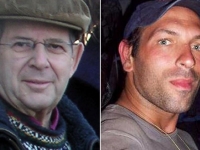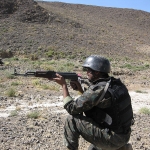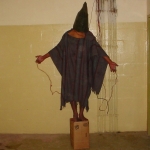Drone, Inc. - B. Thermal & Infra Red Imaging

On January 15, 2015, two U.S. missiles struck a house in Shawal, North Waziristan, setting it on fire and killing everyone inside. The drone crews on the other side of the world had been told to expect four victims. To their astonishment, they watched as six bodies were pulled from the wreckage and given Muslim burials.40
A little over three months later, a grim faced President Obama announced: “One American, Dr. Warren Weinstein, and an Italian, Giovanni Lo Porto ... were tragically killed in a U.S. counter-terrorism operation. …Based on the intelligence that we had obtained at the time, including hundreds of hours of surveillance, we believed that this was an al Qaeda compound; that no civilians were present.”41
Obama’s official statement leaves no doubt that the U.S. intended to bomb the compound and kill all those inside the building. Intelligence officials later said that the more than 400 hours of video compiled over several weeks had determined only four individuals were present, all of whom they believed were militants.42
To comply with 2013 rules requiring “near-certainty” that no civilians were targeted, the analysts had taken another measure. “To make sure nobody else was hiding inside the compound, the CIA used the drone’s heat sensors, which can detect the unique heat signature of a human body,” Adam Entous reported later in the Wall Street Journal.43
What is striking about this admission is that neither the video cameras nor the heat sensor had revealed the presence of two additional adult men living on the premises.
It’s not altogether surprising that video imagery was poor but what is more problematic is that the back-up heat sensor also failed.
The Predator and Reaper use forward-looking infrared sensors (FLIR) that come as standard on both the MTS and the L-3’s Wescam MX series sensor balls. 44 Other drones often use an infrared imager made by Oregon-based FLIR Systems.45
44 Other drones often use an infrared imager made by Oregon-based FLIR Systems.45
FLIR cameras have an advantage over radar because they do not send out pulses that might be detected by a target, while still seeing through smoke, haze, and light fog. Drone operators often use them at night, but even during the day heat signatures are supposed to be able to help analysts detect heat sources such as warm bodies and weapons. However, image quality is limited by humidity, pollution, rain, and distance from the target. (Short-wave infrared cameras are available for low light situations and long-wave infrared cameras are available to penetrate smoke, dust, and clouds, but using both at the same time can be impractical and expensive.)46
There are other problems with FLIR heat sensors. They cannot distinguish one person from the next, cannot see through trees and can be fairly easily thrown off by hot days, the profusion of heat sources in urban areas, and even by a well-placed blanket that dissipates body heat. Nor can they see into basements or underground bunkers.
| Excerpt from conversation between drone personnel watching villagers in Uruzgan, February 2010.50 00:45 (Pilot): What did he just leave there? |
It is also hard to distinguish one inanimate heat source from another, particularly when filming from 10,000 feet and above. Lt. Col. Mark McCurley, a former Air Force drone pilot, who is an unabashed supporter of Predators, reported that a junior analyst he worked with confused a cigarette with the muzzle flash of a gun. “On the infrared screen, smokers at night often looked as if they held a miniature sun in their hand,” McCurley wrote.47
Experts say that thermal imaging can actually reduce the accuracy of targeting because it can lead observers to jump to conclusions. “Seeing according to temperature turns everyone into a potential suspect or target,” writes Lisa Parks, director of the Center for Information Technology and Society at the University of California Santa Barbara. “While other systems of human differentiation and observation are organized around skin color, personal data, and/or facial recognition, aerial infrared imagery turns all bodies into indistinct human morphol- ogies that cannot be differentiated according to conventional visible light indicators of gender, race, or class.”48
But on a winter night in the rural north of Pakistan, the heat sensors should have been operating under optimal conditions. Nonetheless, they were unable
to identify the presence of Lo Porto or Weinstein in Waziristan. Likewise the erroneous killing of Jeremy Smith and Benjamin Rast in Afghanistan was based on the evaluations of heat signatures associated with weapons fire.49 (see previous section)
< Previous • Report Index • Download Report • FAQ/Press Materials • Watch Video • Next >



